UDO shared official details with us on their upcoming Super-6 Synthesizer.
Here’s what they have to say about it:
The Super 6 is a 12-voice polyphonic, Binaural Analog-Hybrid Synthesizer. A harmonious marriage of state of the art FPGA digital hardware oscillators and Voltage Controlled Analog technology. It is flexible, immediate, powerful and refined with a gorgeous analog tone. Rich and evolving textures are easily teased from the unique Super-Wavetable core and can be shaped and manipulated with the binaural analog signal path and flexible modulation. Robust, compact and inviting to pick up and play with smooth, solid and responsive controls throughout, it cries out to be played.
‘Binaural’ refers to the twin synthesizer signal paths. In Binaural mode, each channel ‘ear’ has a complete synthesizer voice. You can detune (and de-phase) the left and right oscillators, amplitude and filter (and indeed other parameters) relative to each-other. The effect is subtle to extreme stereo movement and an improved sense of 3D positioning relative to conventional mono signal-chains panned at the output. It has in this sense 6 “Super voices” that each use two “conventional” voices, hence “Super 6”
UDO Super-6 Overview & Demo:
Key Features:
- 12-Voice Polyphonic Analog-Hybrid Synthesizer
- 4 Octave Fatar Keyboard with Velocity and Aftertouch, Expression and Sustain
- Binaural Analog Signal Path for Stereo Movement and Spatial Effects
- 7-core Super-Wavetable Main Oscillator with Waveform Download
- ]DDS Oscillator 2 with FM, Sync, Sub Oscillator and X-Fade Modes
- Flexible Hybrid FPGA & Analog Voice Architecture
- Robustly Built with Solid, Playable Controls
- Multi-purpose Flexible LFOs, Envelopes & Modulation Matrix
- Arpeggiator & Step Sequencer
- External Audio Input with Audio Trigger
- Dual Stereo 24-bit Digital Effects
Specifications:
- Oscillators
- Two Wavetable FPGA-based Direct Digital Synthesiser Oscillators per voice.
- DDS1 (Direct Digital Synthesizer)
- FPGA Based Super-Wavetable Oscillator Core sampled at 40MHz with Centroid-Oscillator and 6 sister
- oscillators dynamically detuned & de-phased in the stereo field
- Sine, Saw tooth, Squarewave, Triangle, Noise
- 16 Wavetables that can be user-defined
- Range adjustable from 2’ to 64’
- DDS2
- FPGA Based Wavetable Oscillator Core sampled at 40MHz
- Sinewave, Sawtooth,, Square, Triangle, Noise and Pulse Waveforms
- Hard-Sync to DDS1
- Crossfade with DDS1 with adjustable split-point on the keyboard
- LFO Mode
- Sub-Oscillator Mode Active when in LFO Mode
- Variable Pulse Width and PWM
- DDS Modulator
- LFO and Envelope Control of DDS1 & DDS2 Pitch
- Selectable ½ Super or Full Super Mode for DDS1
- Variable Detune Control For Super Waves and Variable Pulse Width control for selected Standard Waves
- LFO and or ENV1 can modulate the depth of Detune for the Super-Waves and the Pulse Width for the
- standard waves
- DDS2 to DDS1 Cross Modulation for Deep FM Sounds
- Audio Input
- Stereo Audio input that can be fed through the 12 Analog Filters and the effects section
- Audio to Gate Trigger with variable-gain input stage
- LFO1
- Main LFO with rate adjustable from 0.05Hz to 20kHz in Low and High frequency modes
- One LFO per-voice implementation
- Left – Right Phase Control for Stereo Effects and Harnessing The Binaural Sound Engine
- One-Shot Mode for Envelope Duties
- Keyboard Tracking Mode for FM sounds
- LFO1 can be mapped through the DDS1 or DDS2 Audio path in either Fixed or Tracking modes for use as a
- Drone or Third-Oscillator
- Free-Running, or Reset on note press or Beginning of Bar for Sequencer/Arpeggiator
- Mixer
- Adjusts Mix-Level of DDS1 and DDS2 Audio Paths
- When in Oscillator X-Fade mode, adjusts Split-Point on Keyboard
- Voltage Controlled Filter
- Analogue 4 Pole Low-Pass Self-Resonant Filter
- Two Levels of Overdrive
- High-Pass Filter with Fixed Frequency or Linked to Low Pass Filter for BandPass response
- Selectable Keyboard Tracking with Filter Autotune For Accurate Keyboard Tracking
- Modulation by ENV1 &/or ENV2, LFO1 and DDS2
- Voltage Controlled Amplifier
- Analogue VCA with Selectable Fixed or Variable Envelope (ENV2)
- Dynamics Control For Velocity Sensitivity
- Modulation By LFO1
- Envelopes
- ENV1 Invertible Hold-Attack-Decay-Sustain-Release, Multiple Destinations
- Looping Mode Selectable Keyboard-Tracking for LFO and FM Duties
- ENV2 Attack-Decay-Sustain-Release, Multiple Destinations
- Keyboard and Controller Section
- 49 key Fatar Mechanism with Velocity and Aftertouch
- Two Axis Bender with LFO trigger
- Voice Modes Poly 1, Poly 2, Variable Size Unison, Solo and Legato
- Keyboard Adjacent Dedicated Controls for Bend Range to DDS1/2 and VCF
- Global LFO2 with Rate and Delay Controls. Triggered and Always-On modes
- Variable Portamento
- Playable Spring-Lever Keyboard Octave Selector
- MPE MIDI Compliance with mapping to Press and Release Velocity, Bend, Poly Pressure and Expression
- Modulation Matrix
- Intuitive Modulation Matrix For Second-Tier Modulation Functions
- LEDs give clear feedback on assignment Depths
- 20x Audio Rate Oversampling Computation
- Arpeggiator-Sequencer
- MIDI Syncable Multimode arpeggiator with Smart-Hold
- 1-4 Octave Range selectable for Arpeggiator
- MIDI Syncable 64 – Step Sequencer with Programmable Note, Rest, Slide and Accent Controls
- LFO1 and Delay Controls CAn be Locked to Arpeggiator/Sequencer Clock
- 64 Sequence Memories
- Effects
- Dual Mode Stereo Chorus using 24-bit 192kHz processing
- Syncable & Modulatable Stereo Delay with 24-bit 192kHz processing
- Performance
- 64 User Patch Memories
- Patch, Sequence & Waveform Management via simple USB ‘Memory Stick’ type interface
- Easy access buttons and a Menu-Free Interface
- IO Connections
- MIDI In, Out and Hardware-Thru on DIN Connectors
- USB For MIDI, Patch & Sequence Management and Waveform Download
- Audio Input on Stereo ¼” Jacks
- Expression Pedal Input. Responds to CV inputs 0-5V and routed to Modulation Matrix
- Sustain Pedal Input. Accepts standard momentary footswitch
- Main Output Left and Right on ¼” Jacks
- High Quality Stereo Headphone Power Amplifier
- Integration
- Easy Disk-Access Patch & Sequence Management and Waveform Download
- (Unlock Multi-timbral Mode) not on release
- (Unlock Deeper Modulation Capabilities) not on release
- Easy OS Upgrade
- Power Supply
- Universal (Worldwide) Mains AC input on IEC C14 Connector
- 30W Power Consumption
- Physical
- Weight approximately 10kg
- Size approximately 846 x 360 x 100 (including feet and knobs)
Details on pricing and availability are to be announced.
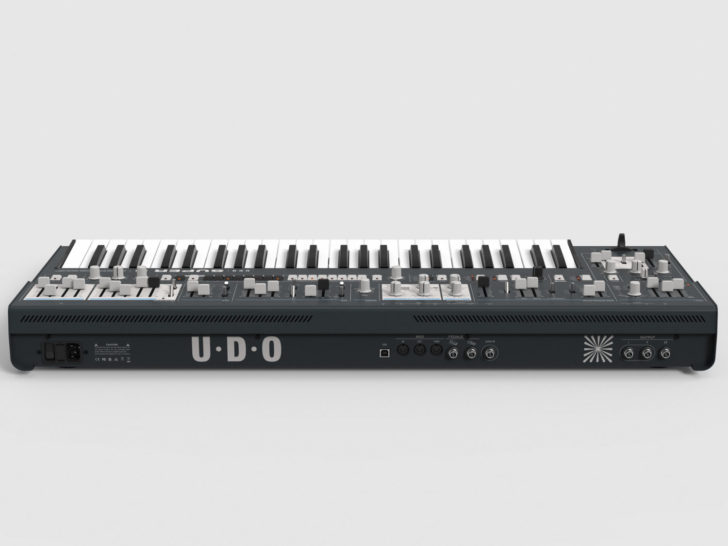

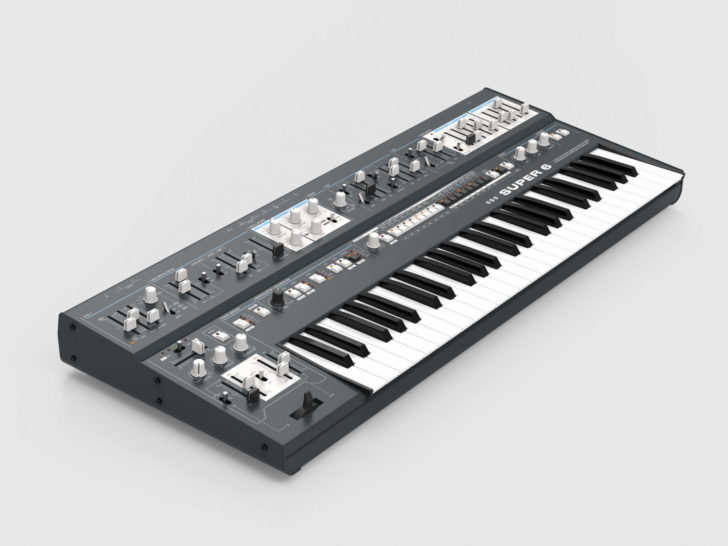






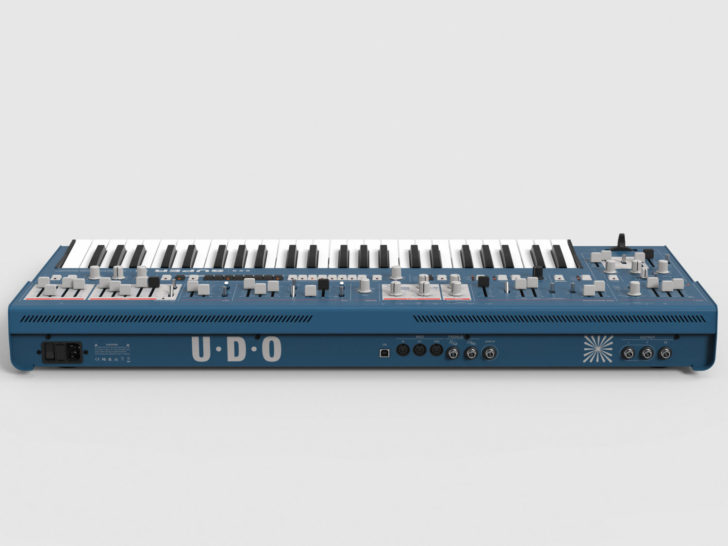



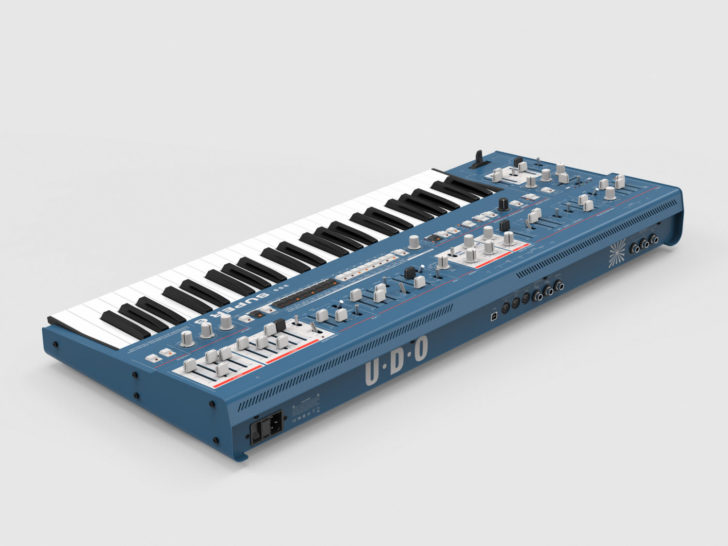
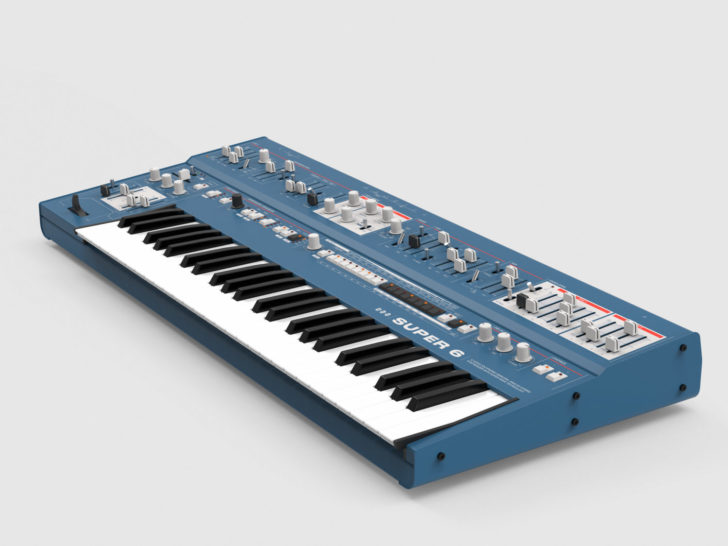




Nice to see specs. Hope this will be available soon, I’ve got a spot picked out for it
People will be putting end cheeks on these bad boys
The most exciting and innovative new synth for a long time- I am so fed up with ‘reissues’, its great to see innovation.
It seems very nice. ?
Shouldn’t they call it the Super 12?
Hi TimS!
They answer your ‘Super 12’ question – maybe you missed it.
Double check the second paragraph– it begins with: ‘Binaural’ refers to…
In short:
” It has […] 6 “Super voices” that each use two “conventional” voices, hence “Super 6” ”
I hope this helped.
Cheers!
maybe if it was usa made
Exciting. Different enough. Not just a copy. Long spec sheet missing the vital one, price. (I know some of the previews have given a guesstimate)
He mentions it in the video: £2000-£2500. So about $3000 USD.
Thanks
Classic must haves combined with new creative ideas, vintage analog combined with high tech, hands on control and NO menudiving.
True Stereo synthesis!
Absolutely positive on this!
The binaural sound seems very similar to the unison mode on the Nord Lead 4. The Super 6 interface seems good but it is very expensive.
How can you say that without using it?
You can choose 2 different wave tables. One for the left and one for the right, Will it sound like unison?
If the price will be about USD 2500, no chances to sell more than a hundred… Of course, intellectual properly but, guys, its manufacturing costs are about USD600 plus taxes…
On what basis do you make that claim of $600 USD manufacturing costs for the above specifications ?
If they’re made on a too order basis there’s going to be little leeway regarding volumetric pricing, a large portion of the manufacturing is going to be 3rd party, i.e.: case design, fatar key bed, internal circuitry, psi etc + assembly costs, shipping to manufacture costs + international shipping to buyer costs and ongoing support.
If one could design and manufacture their own since for under 1k we’d see a lot more boutique gear on the market.
It sounds like you’re living in la la land unless you can prove otherwise I am not buying it.
Alex thinks everyone has the resources of Behringer. Even they couldnt make it at that cost.
figures pulled directly from a fleshy crevice
so you all think $600 dollar cost is low?
Prophet 12 modules are still for sale. Besides binaural, not sure about if this would add much. Sequential probably will come out with a new digital OSC, SSI analog parts based synth soon that is more in mid-range price level to fill the digital gap in the product line. Who knows PFGA as well (PX is FPGA based as well).. but… the more choice and variance, the better….
Looks very cool – I like the idea of separate signal paths for left and right. Been waiting to see what these guys were cooking up since meeting them at a local synth show a few months back.